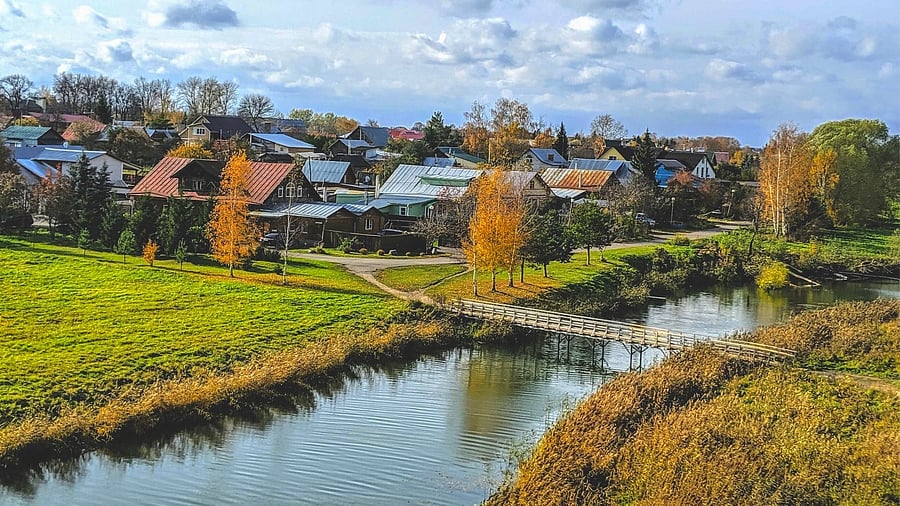
Suzdal has stunning countryside views.
Credit: Meenakshi J
“The Soviets sparing this place, despite the locals’ pleas to be included on the Trans-Siberian route, is still whispered about in hushed tones,” our hostess Irina said with a wry smile, as she warmly welcomed us into her cosy Izba. The air inside carried the comforting aroma of freshly prepared kalina or cranberry jam, and blini — pancakes, thoughtfully made eggless, for us. As we settled into our homestay, Irina busied herself arranging cabbages freshly picked from her garden behind an heirloom samovar that stood proudly on a tiered table, while a black cat curled lazily at her feet.
Our family of three arrived in Suzdal, one of the Golden Ring Russian towns near Vladimir and a UNESCO World Heritage site, for a peaceful autumn weekend getaway from the fast-paced life of Moscow. Fondly referred to as twin towns, Vladimir and Suzdal draw in foreign tourists and Russians alike, eager to experience the heart of the vast country, often arriving in groups by road or bus over the weekends.
Suzdal doesn’t boast the ornate grandeur of Moscow’s metro stations or the secretive bunkers of the Soviets. Nor does it feature the opulent remnants of the Tsars as in Saint Petersburg. What it offers instead is its own unique charm: an open-air museum town untouched by factories or industry, save for its churches and Izbas, almost as if it has taken a quiet vow of austerity. Therefore, it’s not uncommon to see a tear or two escape from visitors like me, struck by Stendhal syndrome while exploring this countryside-sized haven, which is a cornucopia of all things serene and beautiful. Suzdal is a place with one church for every ten people, truly Russian in spirit, and we collectively counted at least 17 churches of varied shapes and colour domes, within a stretch of a few kilometres. In this place, every home grows its own organic vegetables and fruits, and cats roam around freely taking advantage of Russia’s fondness for felines over canines. No wonder doodles, paintings, and colourful cat stickers are everywhere — from petite post boxes hung in front of houses to window panes adorned with playful cat figures.
Irina’s fairytale wooden house was no different. Painted in shades of deep blue and yellow, the homestay stood out even on the already Instagram-worthy street, dotted with charming homes and thriving kitchen gardens. Lovingly built by her carpenter husband with vintage windows framed by Irina’s hand-embroidered white lace curtains, it’s an ode to Russians’ legendary love for intricate window art.
However, as I discovered during my stay through conversations with Irina and local tour guides, Suzdal wasn’t always the tranquil, postcard-perfect town it is today.
In the 10th century, Suzdal’s Kremlin held the centre of political power while Moscow was merely another settlement, situated two hundred kilometres away. It remained a significant trade centre even during the Mongol invasions. As its political significance waned with Moscow’s rise to capital status after the Bolshevik revolution, Vladimir’s prominence rose. But this shift worked in Suzdal’s favour. Its quiet retreat into the bylanes saved the town from the fate of religious
destruction like elsewhere when dictator Stalin dismantled the power of the Russian Orthodox Church. The town’s churches were largely spared and repurposed as stores or warehouses, by the communist regime.
During World War II, Suzdal became a prisoner camp, housing Nazi detainees within the now-pink-hued Saviour Monastery and St Euthymius Museum complex. Perched on a hilltop above the Kamenka River, this imposing structure looms over the quiet town, its dozen battle towers and formidable walls standing as silent witnesses to a turbulent past.
Today, Suzdal’s setting remains remarkably pristine and bucolic. In the commune, paths are lined with rows of Izba — traditional Russian wooden homes with smokestacks, painted in shades of yellow and red that perfectly complement the golden hues of autumn. These rustic structures seem to blend seamlessly with modern life, filling the void left by the absence of overwhelming Stalinist architecture.
The town’s landscape is dominated by the striking blue onion-shaped domes of the whitewashed Cathedral of the Nativity of the Virgin, built in limestone, and located within the Suzdal Kremlin. By the roadside along its walls, chubby babushkas clad in colourful traditional sarafans over pale oversized Rubakhas sell intoxicating drinks of honeyed medovukha. A little further on a wooden bridge over River Kamenka, a few more Suzdal locals hand out steaming hot, potato-stuffed pirozhki, now and then adjusting their vibrant Platoks (scarves). With their warm Duchenne smiles, they effortlessly captivate visitors like me, enticing us to buy their home-made goodies, jams and pickles — and we have no choice but to give in to their elderly charm.
Jostling space with these most affable Russians you could ever meet, are healthy pastoral cattle grazing and modern horse-drawn troikas — creating a striking contrast to the European Saint Petersburg and a very Soviet-tinged Moscow.
As I wandered through Suzdal, I often found myself marvelling at how, in a country scarred by Chernobyl, there exists a town where the air feels as crisp as the higher Himalayas. A place where, in a nation known for its sprawling gentrification and bustling metro stations, you can still find a town — just a few hundred kilometres from Moscow — that remains untouched by industry, save for tourism, and still doesn’t have a railway station to this day.